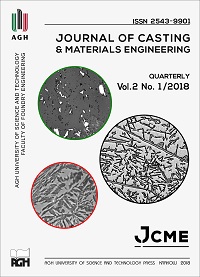Study on Inhibition of N80 Carbon Steel in 0.5M KCl Solution Saturated with CO2 by Gum Arabic
DOI:
https://doi.org/10.7494/jcme.2018.2.1.5Abstract
The effect of Gum Arabic (GA) on the corrosion of an N80 carbon steel pipeline in a CO2-saturated chloride (0.5M KCl) solution was investigated through AC impedance and polarization curves. Potentiodynamic measurements showed that the corrosion current density decreased in the presence of inhibitors and that the inhibitor acts like a mixed-type inhibitor, with anodic predominance. The Nyquist diagrams showed an increase in polarization resistance values in the presence of the inhibitor, thus increasing inhibition efficiency. At higher temperatures, the inhibition efficiency decreased, implying that the inhibition action of GA occurred via the physical adsorption process. The activation parameters of the corrosion process such as activation energies, Ea, and the heat of adsorption, Qads, were calculated, respectively, by the obtained corrosion rate and inhibition efficiency at different temperatures. At higher temperatures, the increase in activation energy combined with the negative levels of the heat of adsorption further supported the physical adsorption nature of the process.
Downloads
References
Verbeken D., Dierckx S., Dewettinck K. (2003). Exudate gums: occurrence, production, and applications. Applied Microbiology and Biotechnology, 63(1), 10–21.
Umoren S.A., Obot I.B., Ebenso E.E., Okafor P.C., Ogbobe O. & Oguzie E.E. (2006). Gum arabic as a potential corrosion inhibitor for aluminium in alkaline medium and its adsorption characteristics. Anti-Corrosion Methods and Materials, 53(3), 277–282.
Abu-Dalo M.A., Othman A.A. & Al-Rawashdeh N.A.F. (2012). Exudate Gum from Acacia Trees as Green Corrosion Inhibitor for Mild Steel in Acidic Media. International Journal Of Electrochemical Science, 7, 9303–9324.
Bentrah H., Rahaliab Y. & Chala A. (2014). Gum Arabic as an eco-friendly inhibitor for API 5L X42 pipeline steel in HCl medium. Corrosion Science, 82, 426–431.
Mobin M. & Khan M.A. (2013). Investigation on the Adsorption and Corrosion Inhibition Behavior of Gum Acacia and Synergistic Surfactants Additives on Mild Steel in 0.1 M H2SO4. Journal of Dispersion Science and Technology, 34(11), 1496–1506.
Umoren S.A. (2008). Inhibition of aluminium and mild steel corrosion in acidic medium using Gum Arabic. Cellulose, 15, 751–761.
Umoren S.A., Ogbobe O., Igwe I.O. & Ebenso E.E. (2008). Inhibition of mild steel corrosion in acidic medium using synthetic and naturally occurring polymers and synergistic halide additives. Corrosion Science, 50(7), 1998–2006.
Tiu B.D.B. & Advincula R.C. (2015). Polymeric corrosion inhibitors for the oil and gas industry: Design principles and mechanism. Reactive and Functional Polymers, 95, 25–45.
Fink J. (2012). Petroleum engineer's guide to oil field chemicals and fluids. Elsevier.
Fink J. (2013). Hydraulic fracturing chemicals and fluids technology. Gulf Professional Publishing.
Cáceres L., Vargas T. & Herrera L. (2009). Influence of pitting and iron oxide formation during corrosion of carbon steel in unbuffered NaCl solutions. Corrosion Science, 51(5), 971–978.
Cheng Y.F., Wilmottb M. & Luoa J.L. (1999). The role of chloride ions in pitting of carbon steel studied by the statistical analysis of electrochemical noise. Applied Surface Science, 152(3–4), 161–168.
Palumbo G., Banaś J., Bałkowiec A., Mizera J. & Lelek-Borkowska U. (2014). Electrochemical study of the corrosion behaviour of carbon steel in fracturing fluid. Journal of Solid State Electrochemistry, 18(11), 2933–2945.
Linter B.R. & Burstein G.T. (1999). Reactions of pipeline steels in carbon dioxide solutions. Corrosion Science, 41(1), 117–139.
ASTM G102 - 89 Standard Practice for Calculation of Corrosion Rates and Related Information from Electrochemical Measurements. (2015).
Fares M.M., Maayta A.K. & Al-Qudah M.M. (2012). Pectin as promising green corrosion inhibitor of aluminum in hydrochloric acid solution. Corrosion Science, 60, 112–117.
Umoren S.A., Obot I.B., Ebenso E.E. & Obi-Egbedi N.O. (2009). The Inhibition of aluminium corrosion in hydrochloric acid solution by exudate gum from Raphia hookeri. Desalination, 247(1–3), 561–572.
Solomon M.M., Umoren S.A., Udosoro I.I. & Udoh A.P. (2010). Inhibitive and adsorption behaviour of carboxymethyl cellulose on mild steel corrosion in sulphuric acid solution. Corrosion Science, 52(4), 1317–1325.
Umoren S.A. & Solomon M.M. (2015). Effect of halide ions on the corrosion inhibition efficiency of different organic species – A review. Journal of Industrial and Engineering Chemistry, 21, 81–100.
Umoren S.A., Solomon M.M., Udosoro I.I. & Udoh A.P. (2010). Synergistic and antagonistic effects between halide ions and carboxymethyl cellulose for the corrosion inhibition of mild steel in sulphuric acid solution. Cellulose, 17(3), 635–648.
Al-Luaibi S.S., Azad S. & Taobi A.-A.H. (2011). Thermodynamic properties of Amino melamine Formaldehyde as corrosion inhibitor for steel in sulfuric acid solution. Journal of Materials and Environmental Science, 2, 148–155.
Nnanna L.A., Owate I.O., Nwadiuko O.C., Ekekwe N.D. & Oji W.J. (2013). Adsorption and Corrosion Inhibtion of Gnetum Africana Leaves Extract on Carbon Steel. International Journal of Materials and Chemistry, 3(1), 10–16.
Downloads
Published
Issue
Section
How to Cite
Accepted 2018-03-08
Published 2018-03-30


